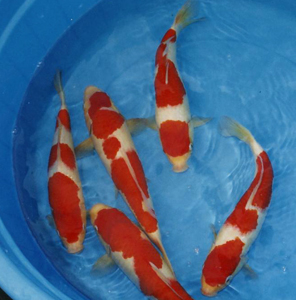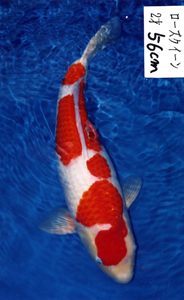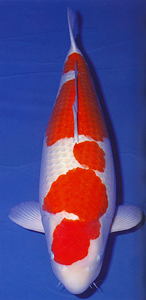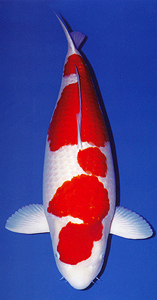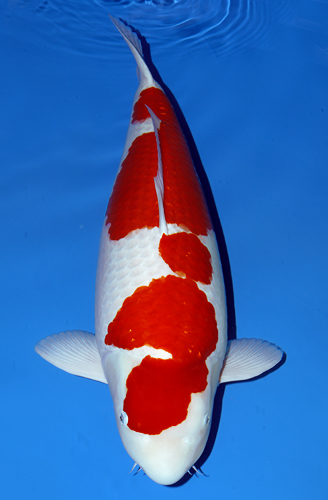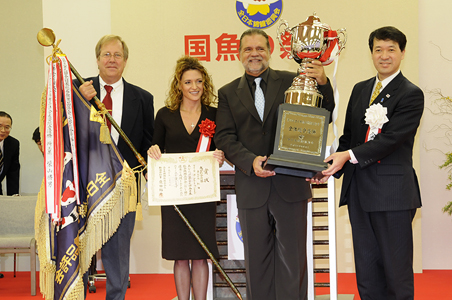The Story of a Champion - Alexandria Kohaku Tategoi is a journey from possibility to reality, a journey that is undertaken against seemingly impossible odds punctuated with incredible risk and awesome rewards. Since the early days of koi keeping, koi dealers have traveled throughout the Japanese countryside visiting numerous breeders in the quest for the perfect candidate to offer to their clients. Japanese breeders spend a lifetime honing their craft with aspirations of creating a koi that can “go the distance”. Although they produce many beautiful creations, the reality is that most breeders consider themselves extremely fortunate if their annual efforts yield even one or two such candidates, true Tategoi. Tategoi of this caliber are so few and far between that the competition between dealers to procure such specimen for their clients is intense to say the least. There is no shortage of koi lovers vying for ownership of exquisite koi. Thus it is through relationships, the dealer’s relationship with the breeder and the hobbyist’s relationship with the dealer, that the course of the Tategoi journey is ultimately determined. In the mid nineties, while Sakai of Hiroshima was laying the foundations for the Rose Kohaku bloodlines that have come to dominate koi competitions around the world, Kentaro Sakai was working here at Pan Intercorp while studying English at a local Community College. Upon his return to Hiroshima, Kentaro took up his duties as Managing Director of Sakai Fish Farms and set about the task of making the name Sakai synonymous with quality, both in Japan and abroad. In the spring of 2002, Sakai successfully spawned Rose Queen, an event which resulted in about 500,000 fry. This was the second year for Rose Queen to be spawned and the Tosai from the first spawning were already showing prodigious potential.
Throughout the growing season, fall, and winter of 2002, the offspring of Rose Queen were selected and re-selected until the final selection in April of 2003. At this point, all that remained of the original 500,000 fry was 150 Tategoi, destined to be grown on as two year olds. Our first photo shows the future Champion at 34 cm in a group setting surrounded by four of her sisters, ready to be released into the mud pond for the 2003 growing season. Although not the greatest of photos, one can note the typically yellow head common to many young Kohaku, but the brilliant white at the shoulder holds the promise of a bright future. At this stage of the game, her pattern had the appearance of a rather crowded Ohmoyo but again the deep wrap of the Beni indicated that her pattern, though not quite as sexy as some of her sisters, would be likely hold up no matter how large she might grow. And grow she did, as is clearly evident in the second photo, 56cm in October of her second year, 17 months old. At this point she was offered at Sakai’s Dealers Auction, where dealers from all around the world vie for some of the finest koi in the world For myself, it was love at first sight. I was absolutely enthralled with this stunning Nisai and immediately contacted Andrew “Flip” Filipowski, who agreed that this was truly a unique opportunity to embark on a Tategoi adventure. We discussed at length the merits and possibilities embodied in this daughter of Rose Queen, and settled on what we believed would be an amply sufficient bid amount and I set off to procure her for Flip. Unfortunately on the day of the actual auction, it quickly became apparent that we were not alone in our appreciation of this fine specimen. The bidding was fast and furious, quickly surpassing our estimation by more than half again and ended up going to a Singaporean dealer for a princely sum. Needless to say, both Flip and I were devastated by this unexpected turn of events, but the die had been cast, so to speak, and there was no choice but to move on. As is the case with many high end koi, this daughter of Rose Queen continued to board with the breeder after the sale, and our third photo shows her at three years old and a robust 68cm While I was visiting Hiroshima during the fall harvest of 2004, I commented on how well she had grown to Kentaro who readily agreed, and in the same breath mentioned that he had just purchased her back from the Singaporean dealer. At three years old we can see that her Beni has become well established and that her Shiroji is undeniably brilliant. At 68cm, her pattern is proving that it is unquestionably the kind of pattern that will stand up on a Jumbo koi. Deep wrap at the shoulder, below the lateral line and on the tail tube captivate the eye and makes for a truly regal appearance. After much discussion, cajoling, imploring and begging, Kentaro finally agreed to part with her for a second time and I called Flip with the news. Flip was elated to have a second opportunity at owning this exquisite koi and tentatively named her “Princess Rose”, a name befitting the daughter of Rose Queen. Flip has always had more interest in koi for the sake of koi development and has not had much interest in showing koi, so it has always been at my instigation that he has conceded to enter his koi into Koi Shows. In January of 2005 Princess Rose made her first public debut at the All Japan Combined Nishikigoi Show where she received the Yusho Jiseki Award 75 bu Kohaku. By this point she was over 70cm and carried her size in a body conformation that promised substantial growth to come in that she was well formed without being overly bulky or massive. It was likely this lack of girth that prevented her from taking an even higher award.
After another growing season of being pampered in Sakai’s mud ponds, Princess Rose had grown to just under 80cm and bulked up nicely. It seemed like the stars were aligning for her and with a little less persuasion than the preceding year, Flip entered her in the 37th All Japan Combined Nishikigoi Show where she triumphed and showed her true colors by becoming the first American owned koi to receive the 80bu Kokugyo Award. “Kokugyo” means “National Fish”, translating to what would be a Best in Size Award in European and American koi shows. Any award at the All Japan level is an achievement that most koi lovers spend a lifetime chasing, but to have a client win a Kokugyo Award at this show was unquestionably the greatest honor that I had experienced in my entire career as a koi dealer. Boarding koi is never without risk. Anyone who has ever owned koi has surely had first hand experience with any number of unforeseen mishaps and disappointments with keeping koi even in the very best of environments. One of the decisions involved with boarding koi in Japan, is to determine the appropriate time to cease boarding and to send the boarder home to her owner. The determination can be dictated by numerous factors such as age, growth, performance and of course potential, just to name a few. An owner will often elect to bring their koi home for final “finishing” or simply because they are ready to enjoy it’s presence on a daily basis. After the 80bu Kokugyo win, I asked Flip if he was ready to bring the Princess home to North Carolina. Flip replied with “Has she done all she can do?” What do you and Kentaro recommend?” Truth be told, there is an enormous amount of stress that goes along with being responsible for a client’s koi and both Kentaro and I would have been relieved if Flip had requested her return, but the consensus was that she was still Tategoi and the decision was made to grow her on for one more year. When Princess Rose emerged from Sakai’s mud pond in the fall of 2006, there was no question that she would be going to the upcoming All Japan Show in January of 2007. She was now 84cm with impressive girth , balanced body, incredible strength in the tail tube, and skin quality that was absolutely to die for. Under Kentaro’s meticulous care in a greenhouse finishing pond, her skin developed a luster that proved impossible to beat as was proven when she was unanimously awarded the 85 bu Kokugyo Award at the 38th All Japan Combined Nishikigoi Show in January of 2007. Yes, the unimaginable had happened, back to back Kokugyo Awards, two years running at the most competitive koi show on the planet. Soon after the 2007 show Princess Rose began to display rapid weight gain, so much so that it became a matter of great concern for everyone. Upon close inspection it became apparent that she was extremely gravid and was carrying so many eggs that she could neither be safely transported nor released into a mud pond. After careful consideration, it was agreed by all involved that the only course was to spawn the Princess to relieve the pressure, and to keep her in an 80,000 gallon concrete greenhouse pond where her progress could be closely observed on a daily basis. Now that she was soon to become a mother, the name “Princess” would clearly no longer be appropriate and Flip renamed her “Alexandria” in honor of his daughter of the same name. Paired with a Sensuke bloodline male from Matsue Nishikigoi Center, Alexandria gave birth to 290,000 fry in the spring of 2007, and was subsequently kept inside for the entire 2007 growing season. When I arrived at Sakai Fish Farm in October of 2007 for the fall harvest Sakai Dealer’s Auction, Kentaro pulled me aside and said “You need to come look at Alexandria”. We zipped over to Sakai’s #10 Greenhouse in a little mini truck where Kentaro grabbed a net and I grabbed a tub. Amazing didn’t begin to describe Alexandria’s condition. For starters, she was huge, enormous, massive. Was it possible that her skin was even better than before? Her Beni was deep and even but not overly red and her white was pristine! I looked at her then I looked at Kentaro. I was overwhelmed with gratitude at the results that his efforts had produced….But did I dare ask the question? I was concerned that putting the thought into words would somehow displease the Kami and put a jinx on her prospects, but I couldn’t help myself, I had to ask. “Do you think she can do it?” Kentaro knew full well what I was asking and took a long time to answer. Perhaps he too feared offending the Kami, replying simply, “I think she might do well”. Kentaro was well aware that the bloom on the flower that is Tategoi can be a fleeting thing and that anything can happen at anytime, which is probably why he suggested that we enter her in the All Japan ZNA Show which was scheduled to be held the following month, rather than risk waiting until the All Japan Combined Nishikigoi Show which was still several months off. Although it was a tempting proposal, it was not possible for Flip to travel to Japan at that time, and by this time I was convinced that we should stay the course and set our sights on the Greatest Show on Earth, the All Japan in Tokyo. At this point in time Alexandria had become so massive that Kentaro felt she needed to go on a diet to slim down before the big Show, To this end, she was moved into a smaller finishing pond in a greenhouse located right outside Kentaro’s residence where he could keep a daily watch on her and closely monitor her diet.
By the last week of January 2008, all that could possibly be done had been done and it was time to transport Alexandria from the Sakai Farm in Hiroshima to the Tokyo Ryutsu Center where the All Japan Show is held. Over 100 boxes of koi belonging to hobbyists from around the world were carefully transported by air, from Hiroshima International Airport to Haneda Airport which is just a few miles from the Ryutsu Center. Alexandria settled in nicely to her show tank on Thursday evening awaiting the judging which commenced on Friday morning. The show was judged by a total of 84 Shinkokai members who’s first task of the day was to select a Grand Champion. Each of the 84 judges has one vote and Grand Champion is determined by a simple majority. The first vote yielded 5 contenders for Grand Champion, a Sanke, two Showa and two Kohaku one of which was Alexandria. The second vote narrowed the field to a Dainichi Showa and Alexandria, and the third and final vote resulted with Alexandria awarded Grand Champion of the 39th All Japan Combined Nishikigoi Show In the years that have passed since I began writing the Tategoi series for KOI USA in 1995, I have been fortunate to have been witness to a number wonderful koi, but never in my wildest fantasies did I dream that I would be have the privilege of procuring a koi that could take Grand Champion at the Greatest Koi Show on Earth, the All Japan Show.
I could doubtless go on and on forever, but suffice to say I am eternally grateful to Andrew Filipowski and Sakai Fish farms for giving Pan Intercorp the opportunity to be a part of the team that brought the All Japan Grand Champion Trophy to America. …And as far as I am concerned, Alexandria is still a Tategoi. All Rights Reserved Joel Burkard/Pan Intercorp Copyright 2008
BACK TO TOP |
||||||||||||||||||||||||
|
|
||||||||||||||||||||||||

